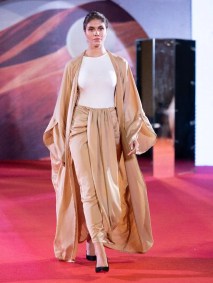The business of modest fashion: an industry born from a women’s movement

Knouz Al Ins gives us an overview of modest fashion, from its religious beginnings to the global, multi-billion dollar industry it is today.
The concept of modest fashion broadly refers to clothing that covers up the body, but has different interpretations depending on who is wearing it. Modest fashion emerged in part thanks to Jewish and Muslim women who observe strict rules around clothing, and who weren’t able to find the clothes they wanted from mainstream retailers and ready-to-wear brands.
While initially motivated by religious beliefs, it’s also chosen by women who want to wear less revealing clothing for a number of reasons – at work for example, while their body is changing due to pregnancy, or for health reasons like protecting their skin from sun exposure.
But it’s not without controversy – for critics it is restrictive and a form of body-shaming, while followers say it is empowering, enabling women to have a choice over how much skin they reveal and avoid scrutiny over how their bodies look.
An online fashion movement
Women-owned brands producing and selling modest fashion began appearing in the early 2000s. One of the first to do this was Rabia Zargarpur, who after starting her label Rabia Z in 2002, became one of the first designers to show models wearing veils on an international runway.
In 2009, she said: “I have been successful so far because I’ve had a niche market [which is] huge and untapped at the moment. My goal is to make [my clothes] available to department stores all around the world.
“I want modesty to look beautiful, and I also want to show a positive side of Islam in media, because unfortunately we only get the negative out there. I want my designs to be a bridge between practising and non-practising Muslims; you don’t always need to show skin to look beautiful, you can look beautiful and remain covered at the same time.”

When British social media influencers Dina Tokio and Amena Khan started posting regularly about their clothing, modest fashion began getting the attention of mainstream brands. By 2015 a number of big clothing companies were launching their own “modest” collections and today Mango, Nike, Dolce & Gabbana and H&M are among the brands capitalising on the trend in an industry valued at $277 billion worldwide.
Online stores like Modanisa – named startup of the week by Wired magazine in 2015 – and Modest Fashion Weeks held in London, Dubai, Jakarta and Istanbul have cemented modest fashion as a cultural force. But like all forms of fashion it isn’t immune to changing trends, influenced by social media and the growing number of fans and entrepreneurs joining the industry.
In or out of the mainstream?

Although it is now influenced by big companies, models and social media, the industry is still largely composed of female entrepreneurs who themselves wear the clothes they are selling. This allows the brands to retain a strong connection to their owners and their original vision.
Among modest fashion entrepreneurs there are those who want to stay out of the mainstream as much as possible – a challenging decision for any business – and those who actively aim to be integrated within mainstream fashion, with different degrees of success.
Take French brand Jennyfer for example, who in 2018 released a collection for Ramadan, a move that a significant number of women from the online Muslim community called opportunist. They claimed that while it was aimed at Middle Eastern regions the clothing didn’t reflect the needs of Muslim women.
Outside of the mainstream, there is a drive towards supporting local businesses, particularly among communities considered minority groups in the Western world, where women are aiming to create an economical sphere formed by other women, buying and selling within their own community.
But there are legitimate reasons to be part of the mainstream fashion industry. Normalising wearing a headscarf in public, and designers getting recognition for what they do are two of them, along with the desire for modest clothing to one day have a place as part of the Fashion Weeks of Paris, Milan and Tokyo.
Knouz Al Ins writes the blog Trésors Anthropologiques and is currently doing a PhD on the link between clothing, religions and aesthetics. Find her at Trésors anthropologiques
READ MORE: “I want to show the world that Muslim women can wrestle”

2 thoughts on “The business of modest fashion: an industry born from a women’s movement”